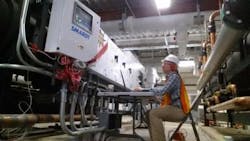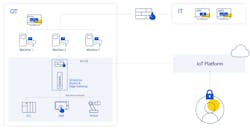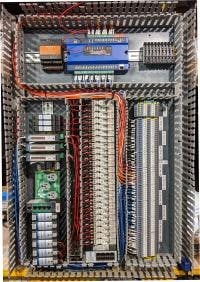Case Study: Cloud-based IoT supports complex control systems from anywhere
By Robbie Hyde, Interface Mechanics
Massive data centers power the internet, digital communications, and countless other information-age resources. Rack after rack of equipment is provisioned with servers and other IT gear, all running advanced software and consuming energy. But among the greatest operating costs is air conditioning to keep these systems cool. Once a data center is in service, even small improvements to cooling efficiency can result in large savings.
Refrigeration methods have become more sophisticated in past decades. In some cases, the developments have outpaced the abilities of those tasked with operating and maintaining them, because these activities require personnel with mechanical, electrical, and software skills.
Operators and technicians working with and supporting utility systems like chillers at commercial, industrial, and data center sites now need high-tech software skills, in addition to mechanical abilities.
In 2010, I could see the increasing need for high-tech integration for these refrigeration systems, so I started Interface Mechanics to bridge the gap. Today we are using modern controller and cloud-interface technologies to perform systems integration (SI) services locally and remotely, making the latest refrigeration advancements accessible for all industries.
The new chill
Heating/ventilation/air-conditioning (HVAC) systems consist of many types of technologies suited for applications at residential, commercial and industrial sites. Traditional industrial-scale refrigeration systems—typically referred to as chillers—use compressors, evaporators, condensers, cooling towers, and other equipment to produce chilled water, which is then used to cool the air inside a building, such as a data center.
Energy savings is usually a key driver for HVAC technology improvement. Over the years there have been many incremental advancements, including variable frequency drives, multi-stage compressors, oil-free and magnetically levitated designs, digital controls, and more.
In commercial HVAC applications, there is an add-on feature called an air-side economizer. If the outside air is cool enough, it can be used to cool the inside air directly, without requiring compressors and refrigerant. Similarly, for industrial applications there is a form of water-side economizer which can perform cooling without compressors if the outside air temperature is low enough. The ability to cool without running compressors offers massive energy savings.
A more recent advancement applicable for data centers is a chiller refrigerant-side economizer. In this configuration, there is no condenser inside the building, and all the refrigerant travels to a coil at the cooling towers, which can run wet or dry. A condenser-less receiver is used, which is a large tank and a small pump. The mechanics of controlling this are more complicated than with other economizer types, and more capable control systems are therefore needed. However, cooling in this mode can lower the energy costs to one tenth of what the traditional compressor/refrigerant method consumes, so it’s more than worth the upfront and ongoing effort required to create and maintain the control system.
Understandable high tech
As Interface Mechanics was automating the first refrigerant-side economizer systems, two things became apparent. First, end users loved these systems because the cost savings was akin to printing money. Second, the technicians and SIs didn’t understand the automation principles and physics of the whole package, so they had difficulty supporting installations. Sites like commercial buildings and data centers are less likely than large industrial sites to have the required multi-discipline personnel available, but support of this type can be a challenge for any organization.
It was clear that a better way was needed to provide visibility to all parties, so the Interface Mechanics team began investigating options for making the operations technology (OT) data available via an information technology (IT) infrastructure [Figure 2].
Some basic requirements included:
- The ability to provide technical visibility for all parties, including the owner, their staff, SIs, equipment OEMs, and Interface Mechanics.
- Easy connectivity will all types of field systems using a range of communication protocols.
- Reliable access via a cloud-based system.
- Ability to transmit OT-sourced data while remaining IT-friendly.
- Native cybersecurity.
Figure 2: An IoT platform built upon AutomationDirect StrideLinx foundations enabled Interface Mechanics to provide secure and capable cloud connectivity and visibility for their advanced chiller applications.
Interface Mechanics already was familiar with and relied on a variety of AutomationDirect components and control products. For example, their STRIDE portfolio includes many types of network switches, industrial internet of things (IIoT) solutions, and accessories. Of particular interest was the StrideLinx VPN router and edge gateway, which could be configured by Interface Mechanics to provide a private-labeled IoT platform to meeting the needs of their customers.
Cool connectivity
A local control panel was needed to provide the control and I/O interfaces, as well as the network communication elements, so Interface Mechanics created a basic design that would be adaptable to most all projects of this type [Figure 3]. The panel needed terminal blocks, power distribution, power supplies, networking devices, and other components.
Figure 3: A local control panel was assembled using a variety of AutomationDirect terminal blocks, power supplies, networking devices, and other components. It was designed to interface the OT field systems with the IT cloud.
Programmable logic controllers (PLCs) or other proprietary controllers would provide data collected from field devices, using a range of protocols to collect and transmit this information. Interface Mechanics developed a Linux-based Raspberry Pi controller running Node-RED to support the necessary data handling and created mobile apps for providing live dashboarding [Figure 4].
Interface Mechanics has branded the resulting solution as LogBus, and has placed it service at many sites. Mobile apps are available for both Android and iOS, providing convenient and secure access from anywhere at any time. LogBus has also been extended to work with other HVAC elements, such as boilers. End users and their personnel can now easily monitor the system operation from their mobile devices and be alerted to any exceptions. OEMs and SIs can access the equipment and monitor performance. Some clients want read-only functionality, while others need the ability to make changes such as setpoint values. The IoT platform is paired with Node-RED to accomplish the necessary data flows with the dashboard as required by the application.
Figure 4: The cloud IoT platform solution uses mobile apps to securely present real-time data displays to operators, SIs, OEMs, and any personnel tasked with supporting the advanced chiller systems.
This cloud-capable IoT platform makes it practical for modern—and sometimes complex—technologies to be deployed anywhere, and then successfully supported, regardless of what local staff is available. In many cases, remote monitoring can predict problems before they happen, providing the information required for proactive maintenance. Cloud connectivity lets support experts from around the world effectively and securely work on these systems, supplementing local staff as required, or providing complete support if desired by the customer.
In the latter case, Interface Mechanics monitors systems remotely, and makes changes and adjustments as needed. If an issue cannot be addressed remotely, Interface Mechanics staff travel to the site to perform the required tasks.
Refrigerant-side economizer systems and other advanced technologies can increase the efficiency of the cooling systems used at server farms and other facilities. These systems can be complex to operate and maintain, but remote monitoring, coupled with remote service if required, addresses these and other issues, allowing facility owners to save money without the need to hire additional highly skilled staff.
[All figures courtesy of Interface Mechanics]




